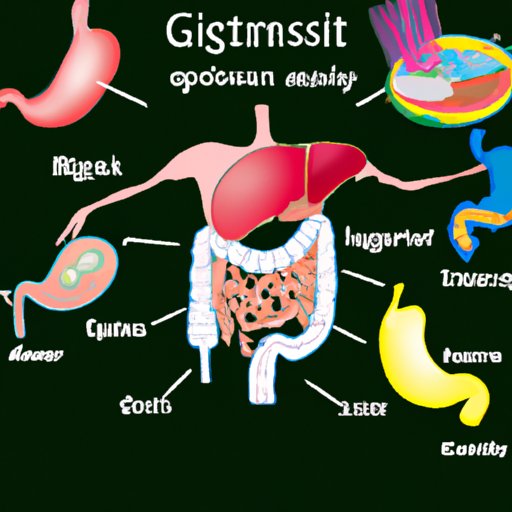Introduction
Digestion is the process by which the body breaks down food into smaller molecules that can be absorbed and used for energy. It is an essential part of life, yet it is often taken for granted. Understanding the anatomy and physiology of human digestion is key to understanding how our bodies absorb and utilize nutrients.
The purpose of this article is to provide a comprehensive guide to understanding where digestion occurs in the human body. We will explore the anatomy of human digestion, examine the physiology of digestive processes, and take a closer look at the different stages of digestion.
A Comprehensive Guide to Understanding Where Digestion Occurs
The digestive system is composed of a series of organs, including the mouth, esophagus, stomach, small intestine, large intestine, and rectum. Each of these organs has its own unique functions and plays an important role in the breakdown and absorption of food.
Exploring the Anatomy of Human Digestion
The process of digestion begins in the mouth, where food is chewed and mixed with saliva. Saliva contains enzymes that help break down carbohydrates, while the teeth break down proteins and fats. The partially digested food then moves down the esophagus to the stomach. The stomach is a muscular organ that secretes hydrochloric acid and enzymes to further break down the food. The partially digested food then moves into the small intestine, where most of the digestion and absorption of nutrients takes place.
The small intestine is filled with tiny projections called villi, which increase the surface area of the small intestine and aid in absorption. The small intestine is also home to enzymes produced by the pancreas and bile from the liver. These enzymes and bile break down lipids, proteins, and carbohydrates into smaller molecules that can be absorbed through the walls of the small intestine.
The partially digested food then moves into the large intestine, where water and vitamins are reabsorbed. The large intestine is also home to bacteria that help break down undigested food particles. The waste products of digestion are then eliminated through the rectum.
Examining the Physiology of Digestive Processes
The digestive process is complex and involves many different hormones, enzymes, and organs. Hormones released by the brain and gastrointestinal tract stimulate the production of digestive juices, while enzymes produced by the pancreas and liver break down food particles into smaller molecules that can be absorbed. The stomach muscles contract to mix the food and digestive juices and move the food particles through the digestive tract.
The organs of the digestive system work together to break down food and absorb the nutrients. The saliva helps to break down carbohydrates, the stomach secretes hydrochloric acid and enzymes to break down proteins, and the small intestine absorbs nutrients. The liver produces bile to aid in the breakdown of fats, and the large intestine absorbs water and vitamins.

A Closer Look at the Different Stages of Digestion
An Overview of the Major Organs Involved in the Digestive System
The digestive system consists of several major organs: the mouth, esophagus, stomach, small intestine, large intestine, and rectum. Each of these organs has its own unique functions and plays an important role in the breakdown and absorption of food.
The mouth is responsible for chewing and mixing food with saliva. The esophagus transports food from the mouth to the stomach. The stomach secretes hydrochloric acid and enzymes to break down food particles. The small intestine absorbs nutrients, while the large intestine absorbs water and vitamins. The rectum eliminates waste products.
Analyzing the Role of Enzymes in Digestive Processes
Enzymes play an important role in the digestive process. Enzymes are proteins that speed up chemical reactions and are found in saliva, the stomach, and the small intestine. Salivary amylase helps to break down carbohydrates, while proteases and lipases break down proteins and fats, respectively. These enzymes are essential for the digestion and absorption of nutrients.
Conclusion
In conclusion, digestion is the process by which the body breaks down food into smaller molecules that can be absorbed and used for energy. The organs of the digestive system work together to break down food and absorb the nutrients. The mouth chews and mixes food with saliva, the stomach secretes hydrochloric acid and enzymes to break down proteins, and the small intestine absorbs nutrients. Enzymes play an essential role in the digestive process, helping to break down carbohydrates, proteins, and fats into smaller molecules that can be absorbed. Understanding the anatomy and physiology of human digestion is key to understanding how our bodies absorb and utilize nutrients.
Summary of Key Points
- Digestion is the process by which the body breaks down food into smaller molecules.
- The organs of the digestive system work together to break down food and absorb the nutrients.
- Enzymes play an essential role in the digestive process, helping to break down carbohydrates, proteins, and fats.
- Understanding the anatomy and physiology of human digestion is key to understanding how our bodies absorb and utilize nutrients.
Final Thoughts
Digestion is an essential part of life, and understanding where digestion occurs in the human body is key to understanding how our bodies absorb and utilize nutrients. This article has provided a comprehensive guide to understanding the anatomy and physiology of human digestion, as well as a closer look at the different stages of digestion and the role of enzymes in the digestive process.


